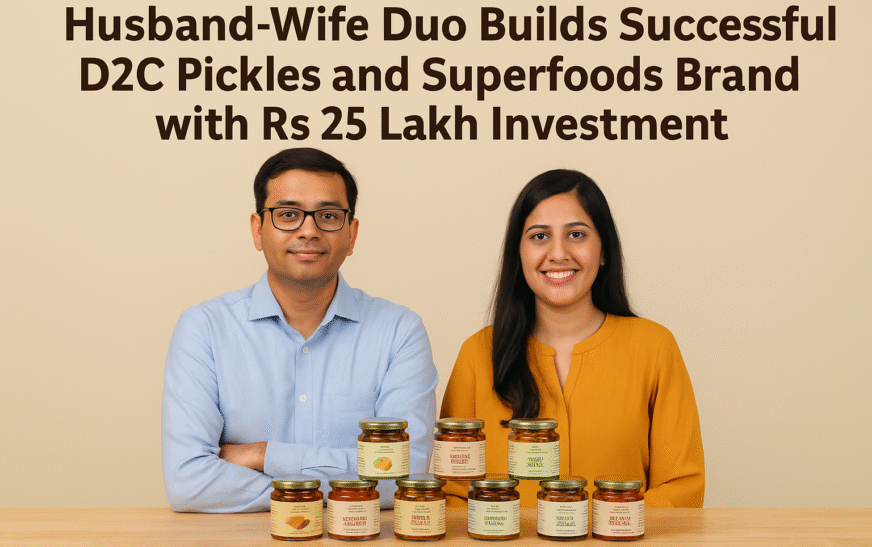In an era where Direct-to-Consumer (D2C) brands are redefining traditional retail, an inspiring husband-wife duo has made waves by launching a D2C pickles and superfoods brand with a modest Rs 25 lakh investment business idea. Within just one year, they grew their customer base to over 8,000 loyal buyers across India.
Their journey is a lesson in resilience, strategic thinking, and the power of staying authentic in a crowded market. This detailed article covers their founding story, funding strategy, marketing moves, challenges, and tips for aspiring entrepreneurs.
The Origin Story: Turning a Family Recipe into a Scalable Business
The husband and wife behind this successful D2C pickles and superfoods brand always shared a passion for traditional Indian recipes. During the COVID-19 lockdown, they experimented with homemade pickle and realised there was a clear market gap: customers wanted authentic taste, clean ingredients, and convenient delivery.
They decided to bootstrap their idea with an Rs 25 lakh investment business plan, pooling in personal savings and taking a small loan from family. Their vision was to make high-quality, preservative-free pickles and superfoods accessible across India.
Key Steps in Ideation:
Researching customer preferences through online surveys
Sourcing local, chemical-free ingredients
Developing small batches to test recipes
Branding the business around authenticity and health
Their initial plan focused on three popular pickle variants and two superfood blends to avoid overextending production capacity.
Building a Lean, Digital-First D2C Brand
One of their biggest competitive advantages was going 100% Direct-to-Consumer. By cutting out middlemen, they offered fresher products at better prices while owning the entire customer experience.
They invested in:
A Shopify website with easy checkout
Professional product photography
Strong social media presence (especially Instagram and WhatsApp)
Google Ads and Facebook Ads targeting health-conscious millennials
Their D2C pickles and superfoods brand quickly built traction, with the first 1,000 orders arriving in three months.
Pro Tip for Entrepreneurs: Start small but invest in high-quality branding and customer service—it’s what keeps people coming back!
Smart Use of Rs 25 Lakh Investment
Many entrepreneurs wonder how they spent their Rs 25 lakh investment so efficiently. Here’s a simplified breakdown:
₹8 lakh for raw materials and packaging
₹5 lakh for renting a small FSSAI-certified kitchen
₹4 lakh for website, photos, branding
₹3 lakh for digital ads
₹2 lakh for delivery partnerships and software tools
₹3 lakh kept aside as working capital
By keeping their burn rate low and choosing only essential marketing channels, they ensured they wouldn’t run out of funds before achieving traction.
Customer Experience and Retention Strategy
Serving over 8,000 customers in one year isn’t just about acquiring new buyers; it’s about getting repeat orders. The husband-wife duo focused heavily on:
Quick delivery times (3–5 days pan-India)
Eco-friendly packaging
Handwritten thank-you notes
Transparent ingredient labelling
Loyalty discounts for repeat buyers
These personal touches made the brand stand out in the highly competitive D2C pickles and superfoods segment.
Result? Over 40% of their sales came from repeat customers within the first year.
Marketing Tactics That Worked
Their marketing approach was simple but effective:
Storytelling: Sharing their journey as a husband-wife team making pickles from family recipes built trust and relatability.
User-Generated Content: They encouraged buyers to post unboxing videos and reviews on social media, building organic buzz.
Regional Targeting: Ads focused on urban centres with health-conscious buyers willing to pay for quality.
They also partnered with food bloggers and micro-influencers for barter collaborations, stretching their marketing budget even further.
Overcoming Challenges in Scaling
No business is without hurdles. They faced:
Sourcing consistency for ingredients
Hiring trained kitchen staff
Navigating changing FSSAI compliance rules
Managing cash flow during seasonal demand spikes
They solved these by:
Establishing direct farmer relationships
Training local women as part-time workers
Investing in better inventory planning software
Negotiating credit terms with suppliers
Their focus on solving problems quickly was key to surviving the first year.
Results in Just One Year
Here’s what they achieved in 12 months:
Over 8,000 customers served pan-India
40% repeat customer rate
Consistent 4.8/5 product ratings on their website
Profit margins are around 30% despite the small scale
Break-even achieved in 10 months
This growth proves that a Rs 25 lakh investment business can become a thriving D2C brand with the right strategy and execution.
Advice for Aspiring Entrepreneurs
When asked what advice they’d give to others, they shared:
✅ Start with a small product line to avoid complexity
✅ Don’t compromise on quality or authenticity
✅ Invest in building a loyal customer community
✅ Keep costs low but brand value high
✅ Use social media storytelling to differentiate
This approach helped them turn their passion into a successful husband-and-wife business success story in India’s crowded food industry.
The Future of Their D2C Pickles and Superfoods Brand
After one year of impressive growth, the couple has ambitious plans:
Expanding their product range with chutneys and sauces
Entering international markets via Amazon Global
Opening an experience store in their city
Partnering with local farmers for organic certifications
Their goal is to become India’s most trusted name for artisanal pickles and superfoods while empowering rural communities with fair wages and skill-building.
Final Thoughts on Building an Rs 25 Lakh Investment Business
This story is a powerful reminder that you don’t need VC funding or a huge factory to succeed. With Rs 25 lakh, smart planning, and relentless focus on quality, a husband-wife business success can thrive even in competitive spaces.
Their D2C pickles and superfoods brand proves that the right mix of tradition, technology, and customer care can turn even the simplest idea into a fast-growing brand.













